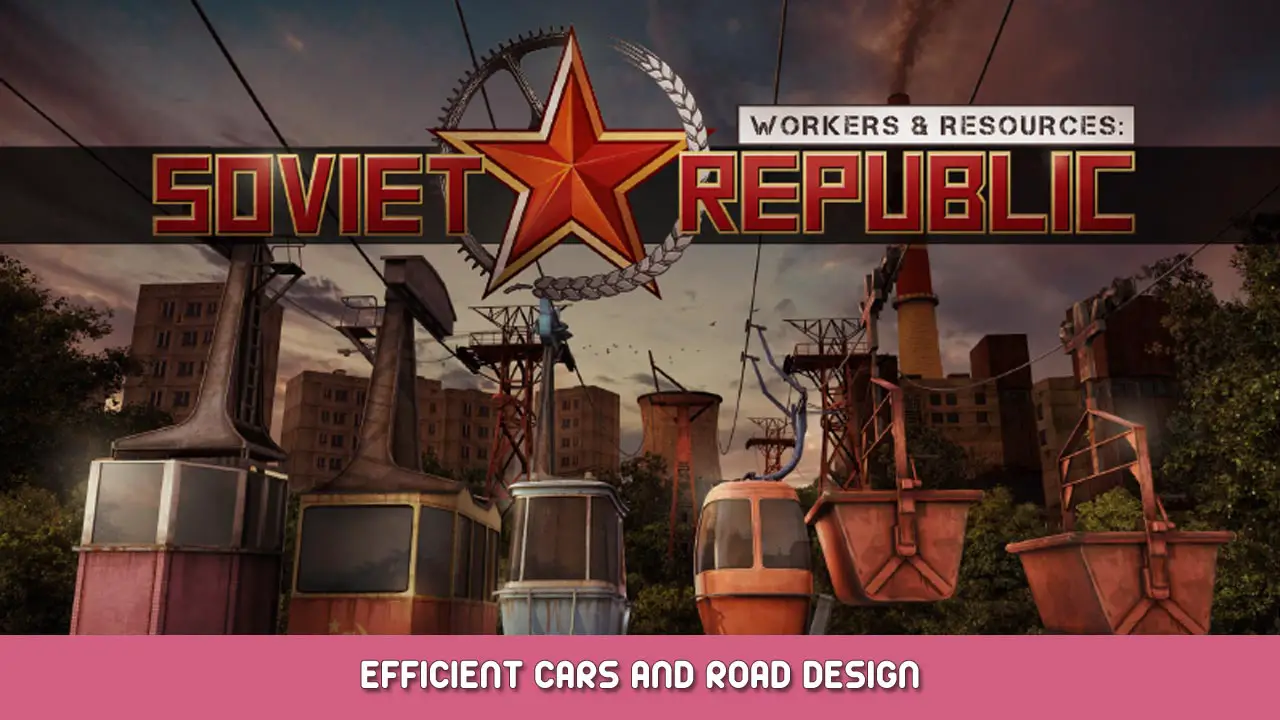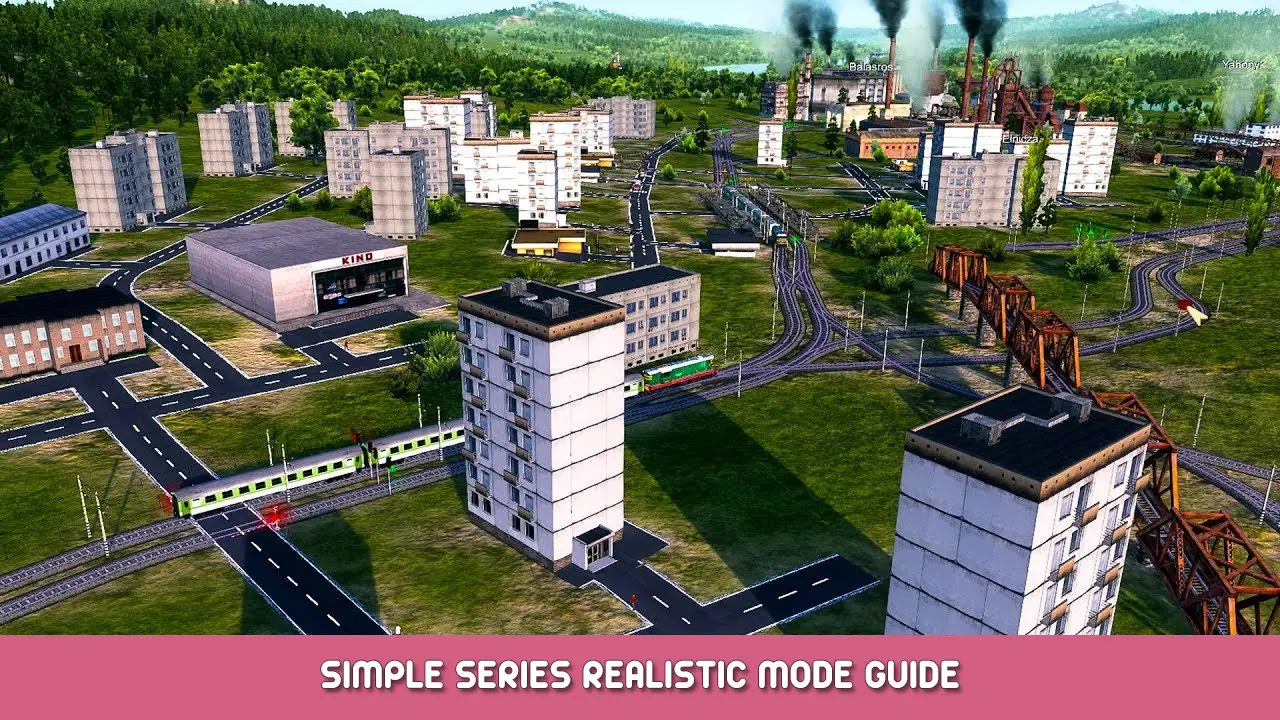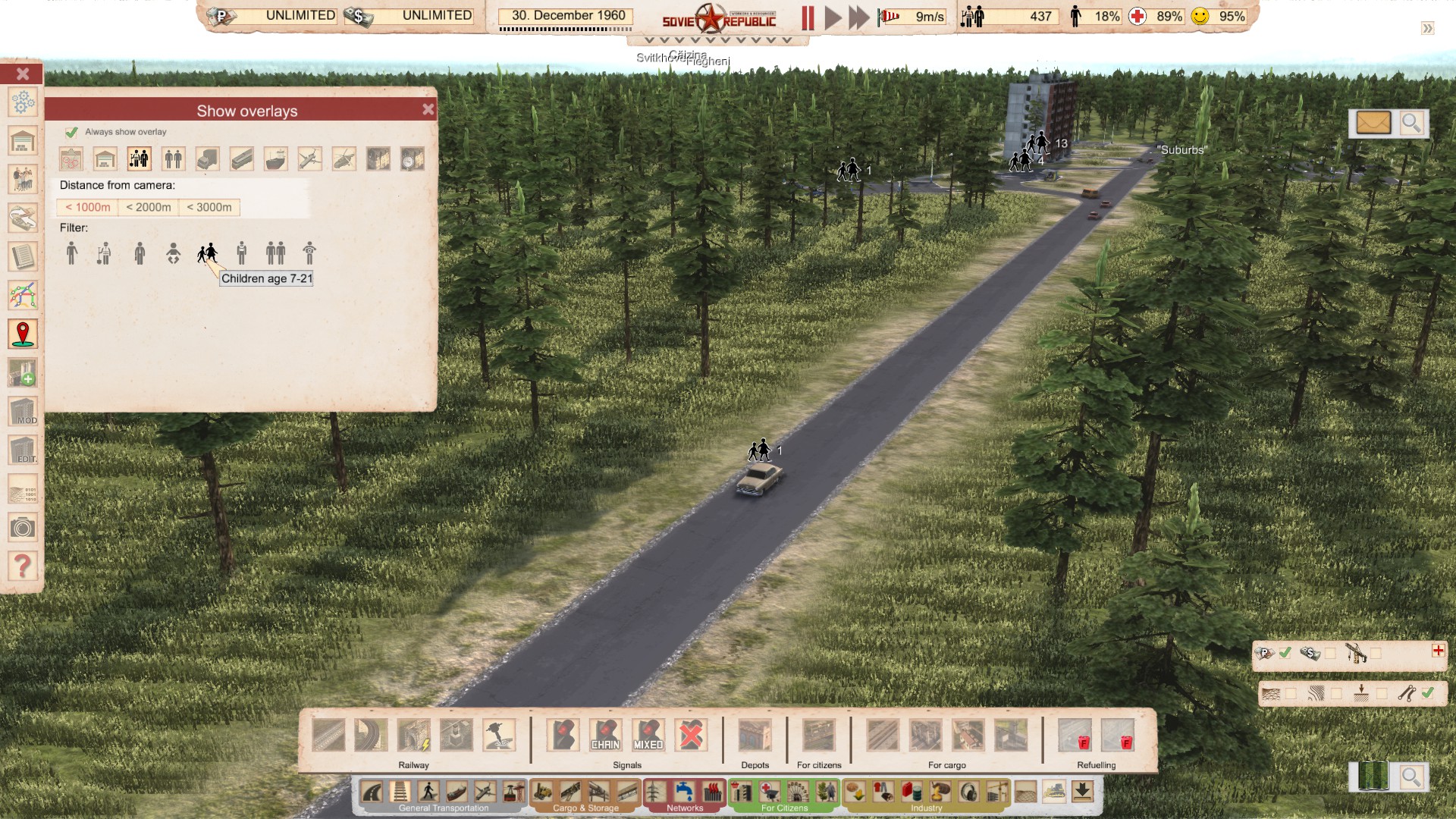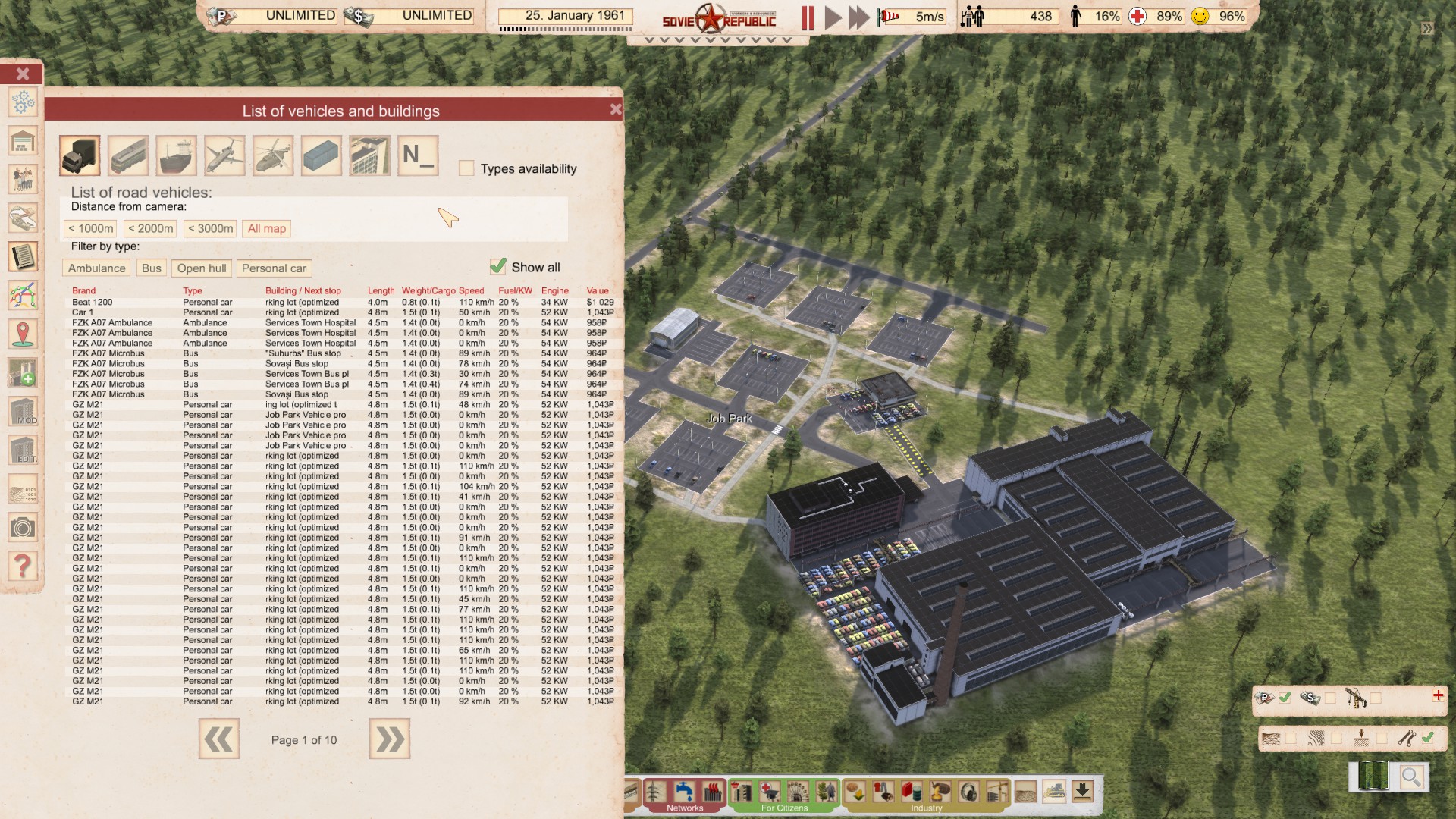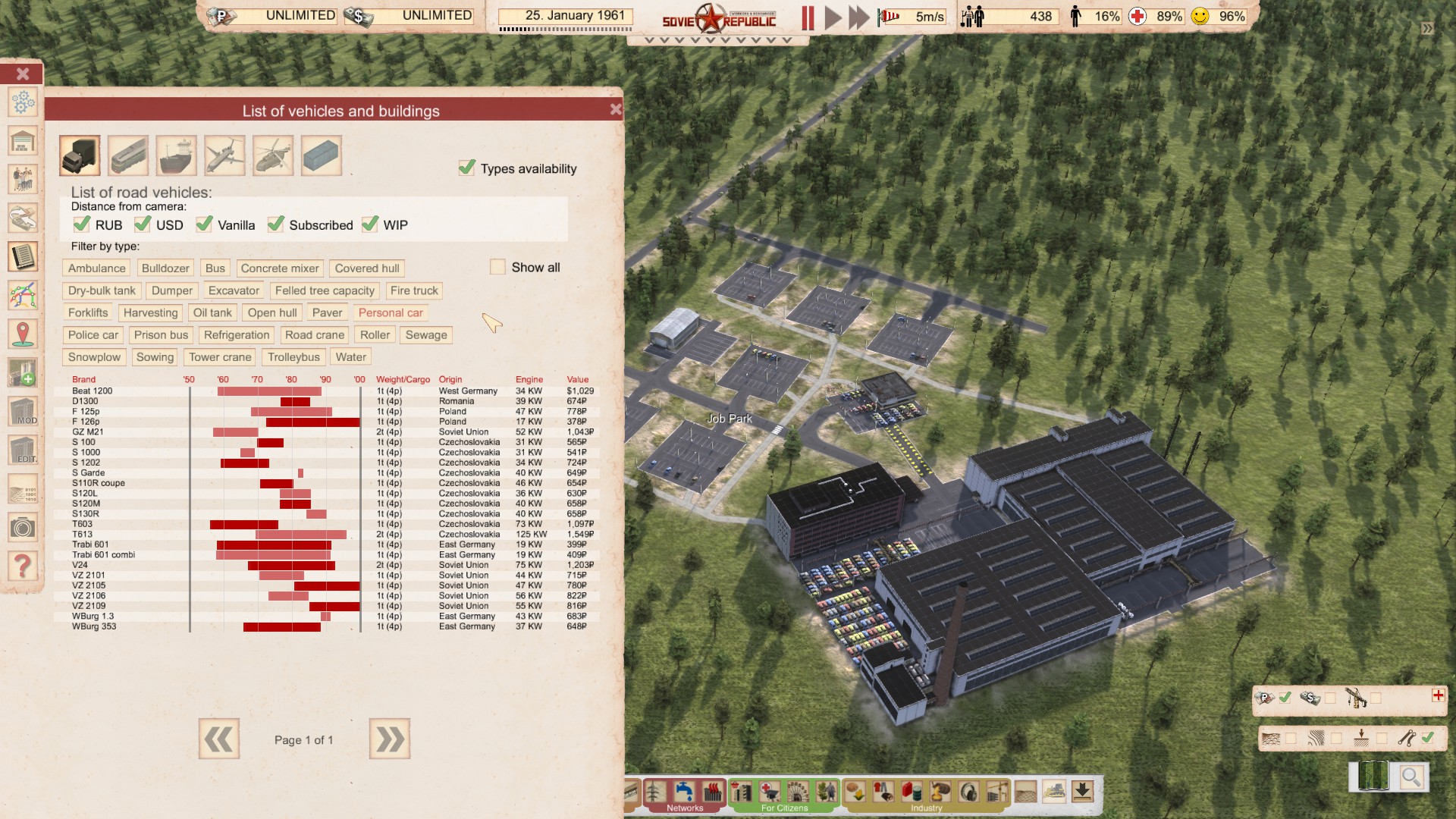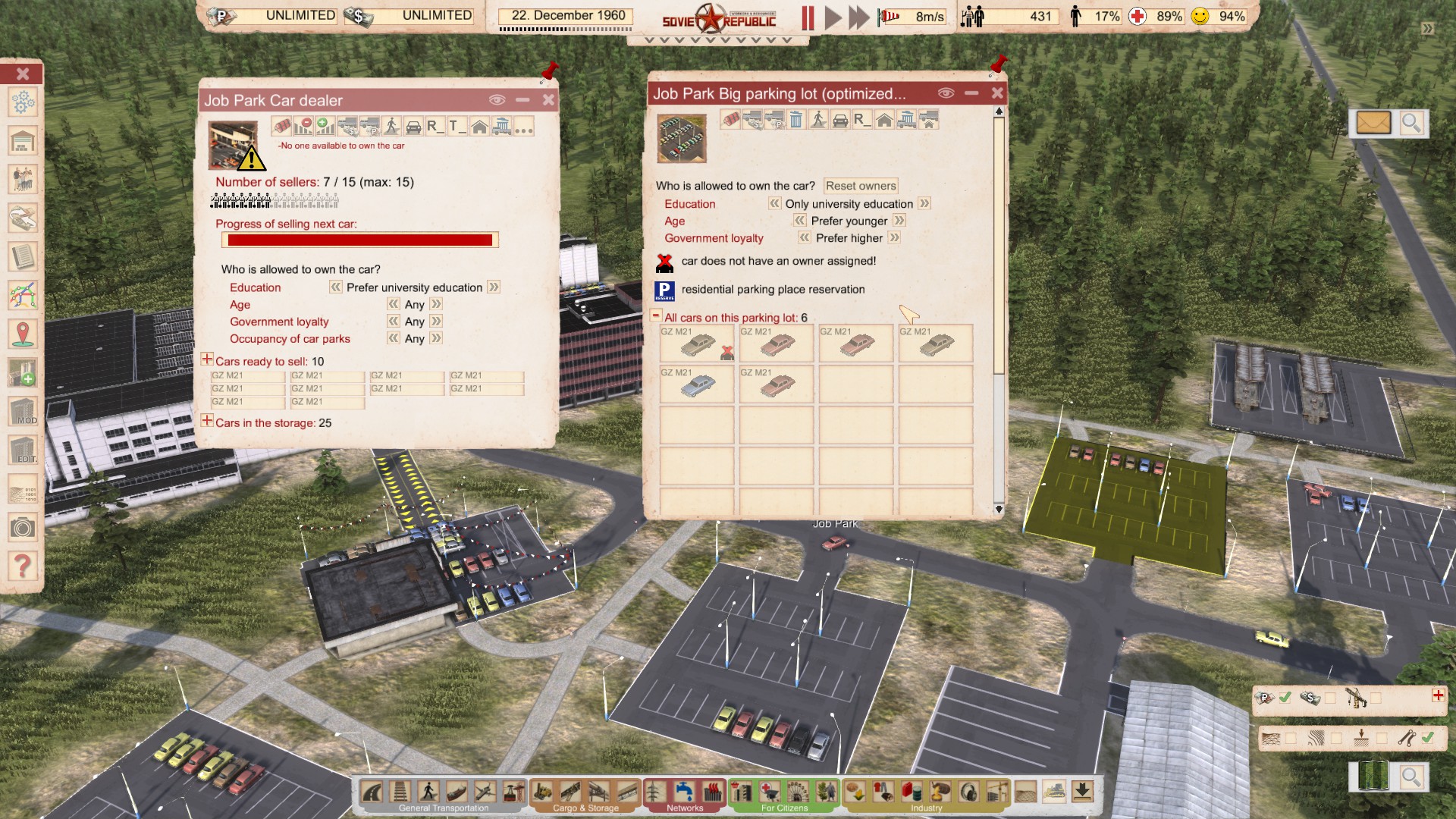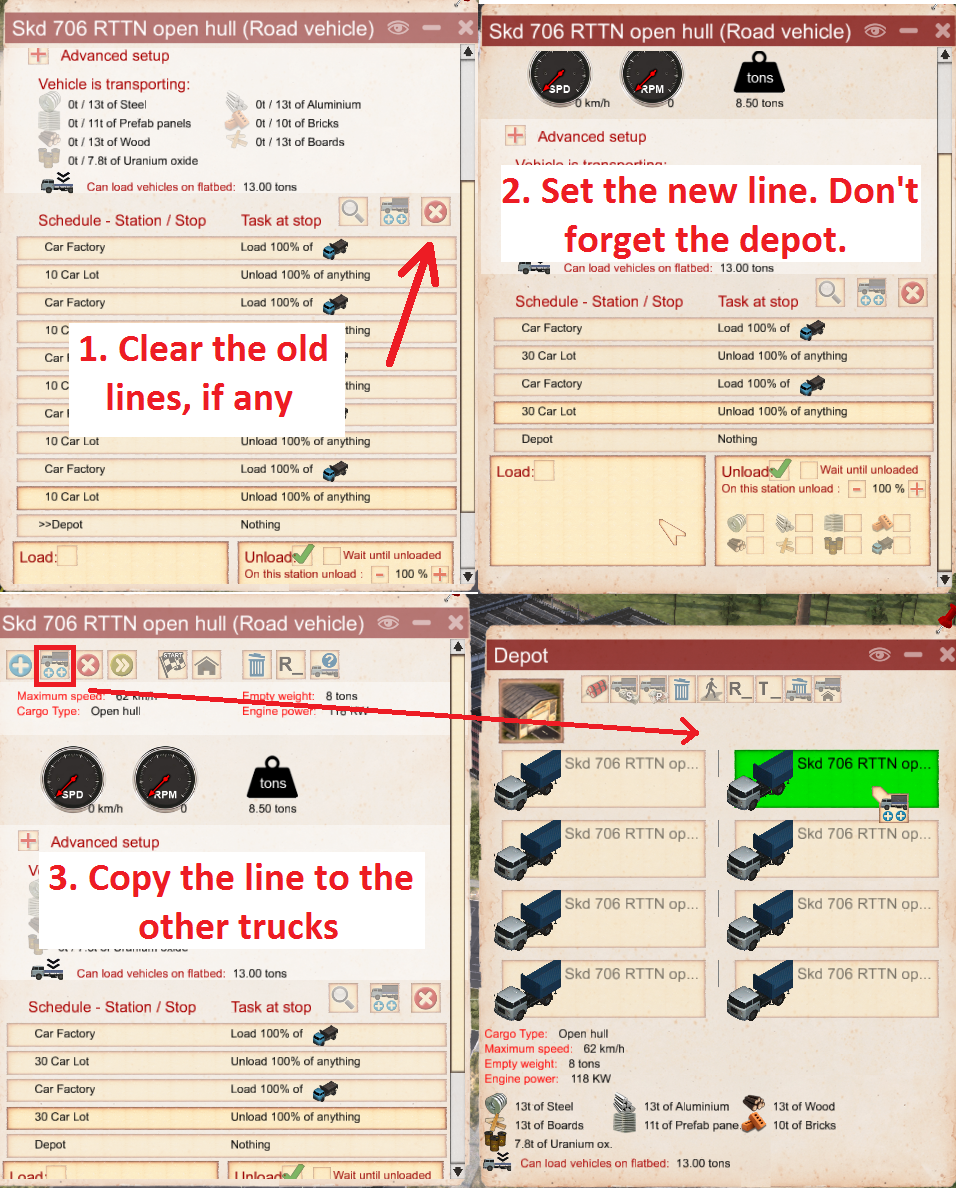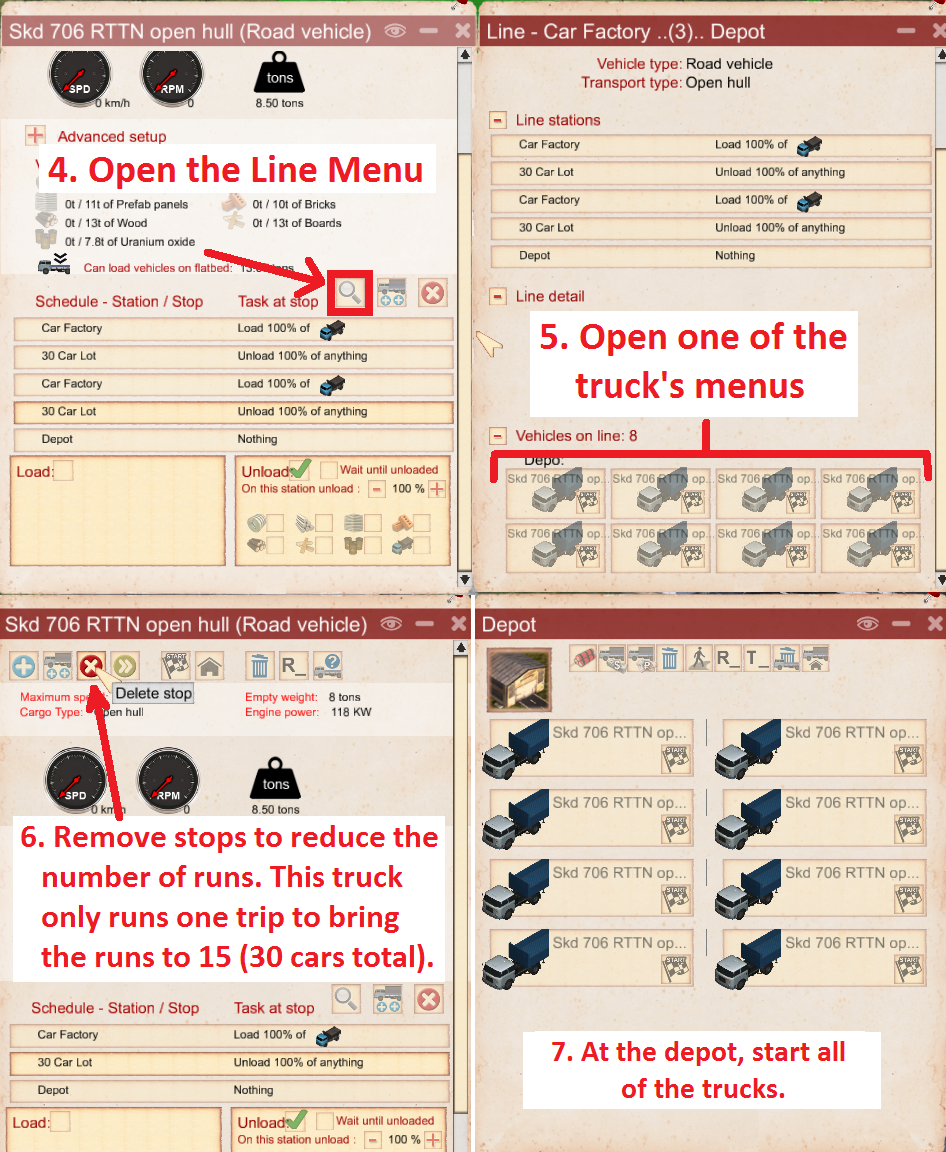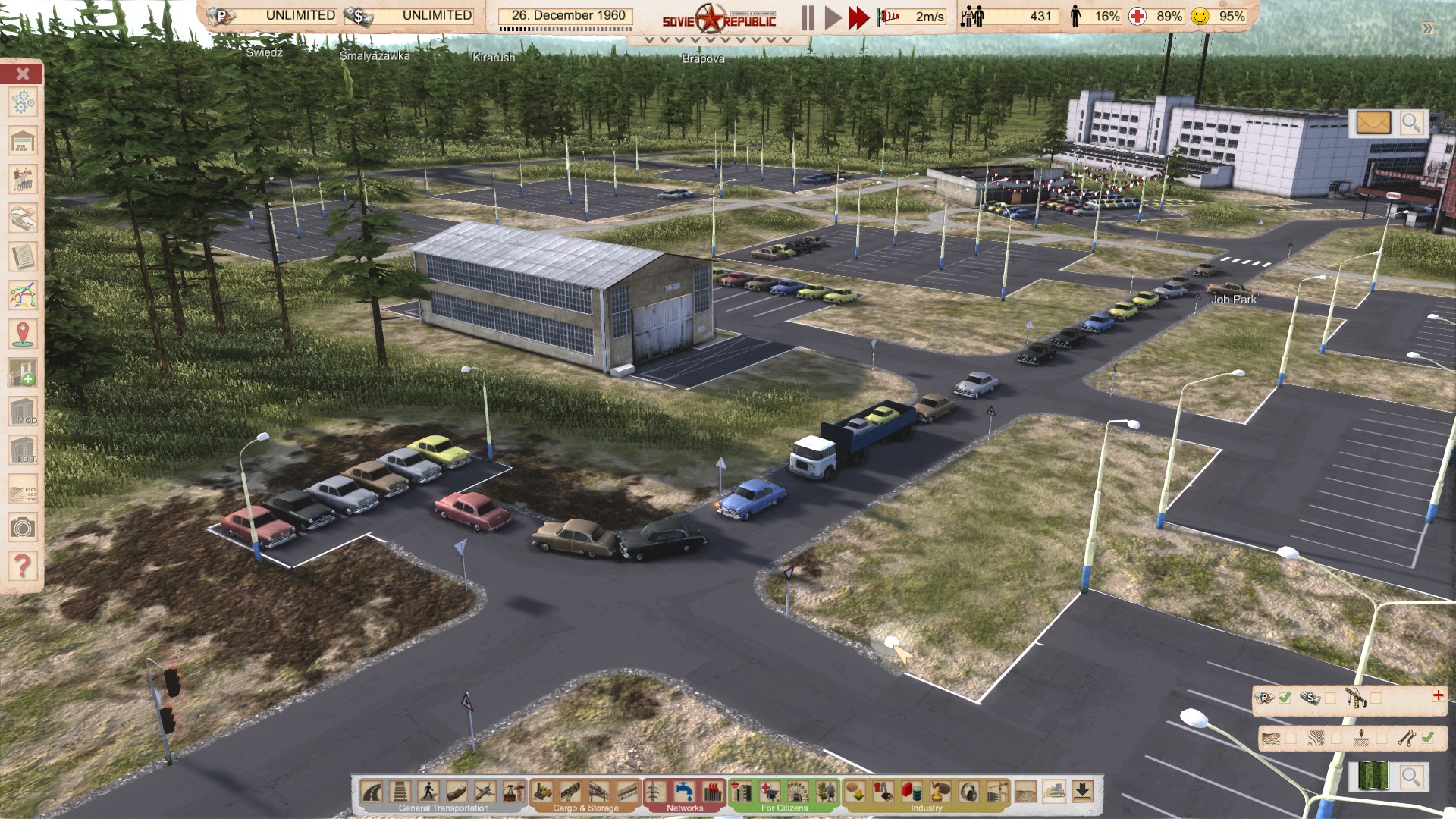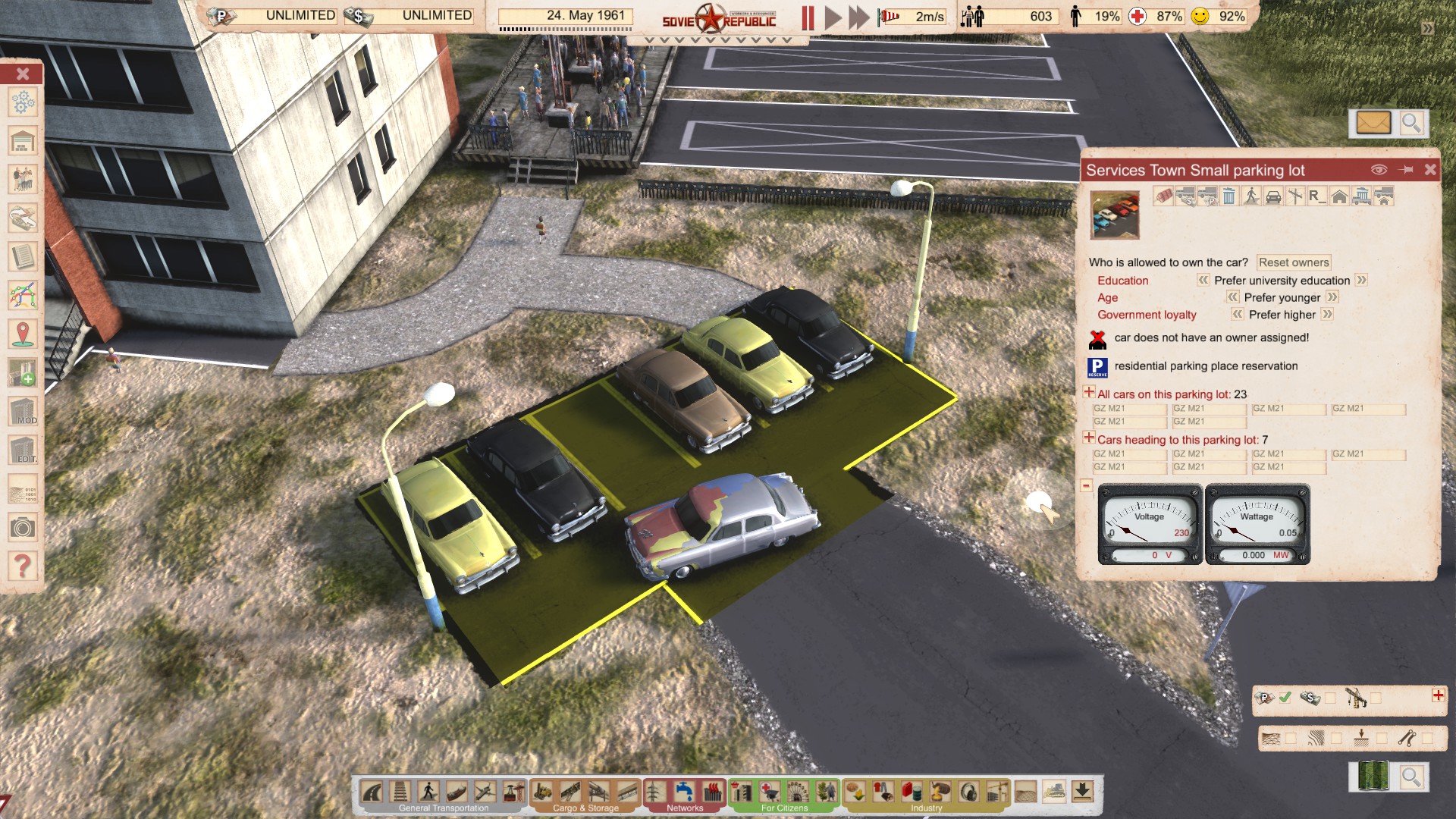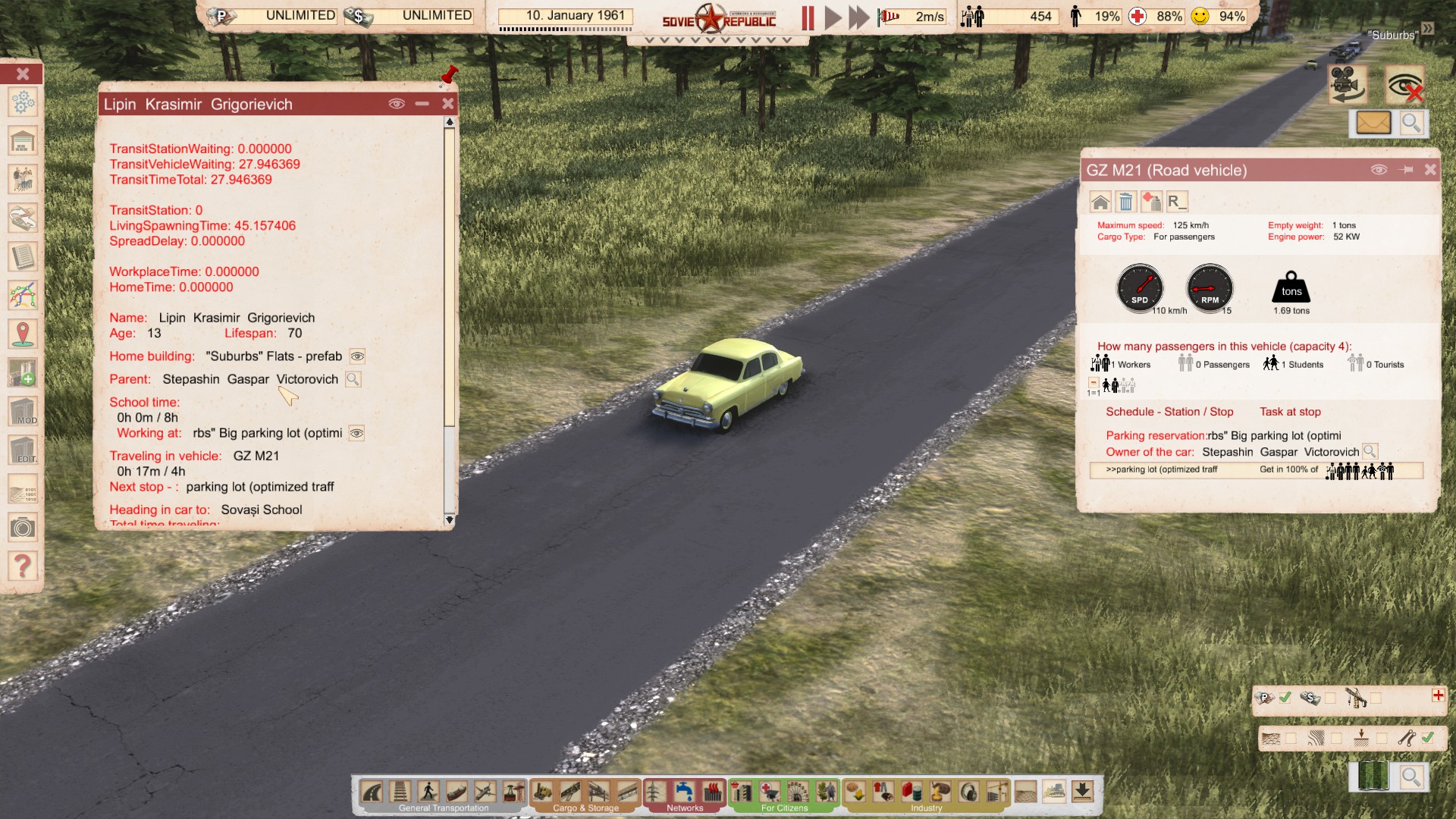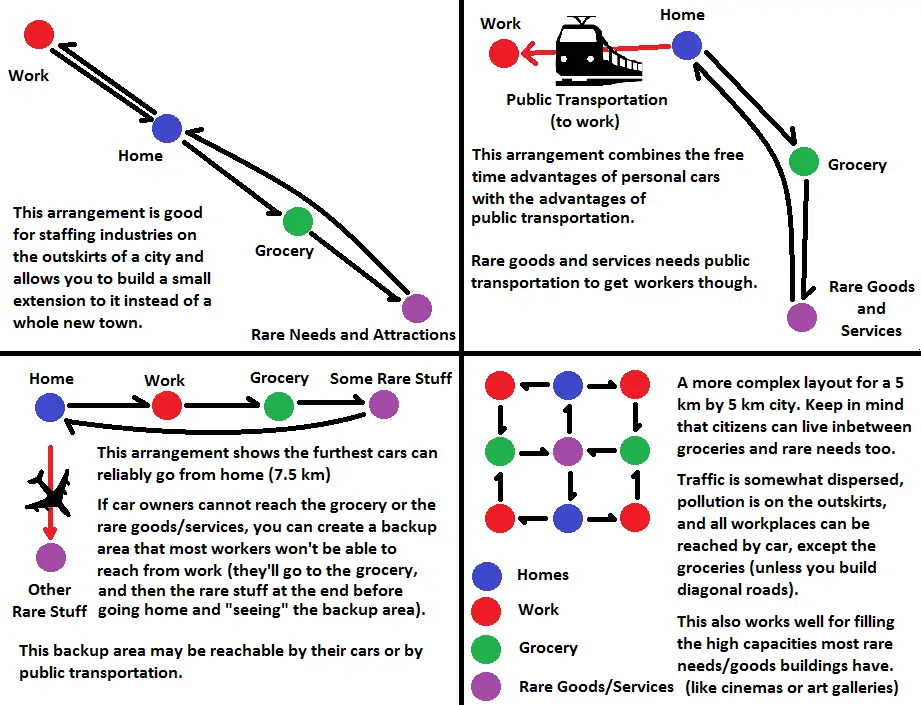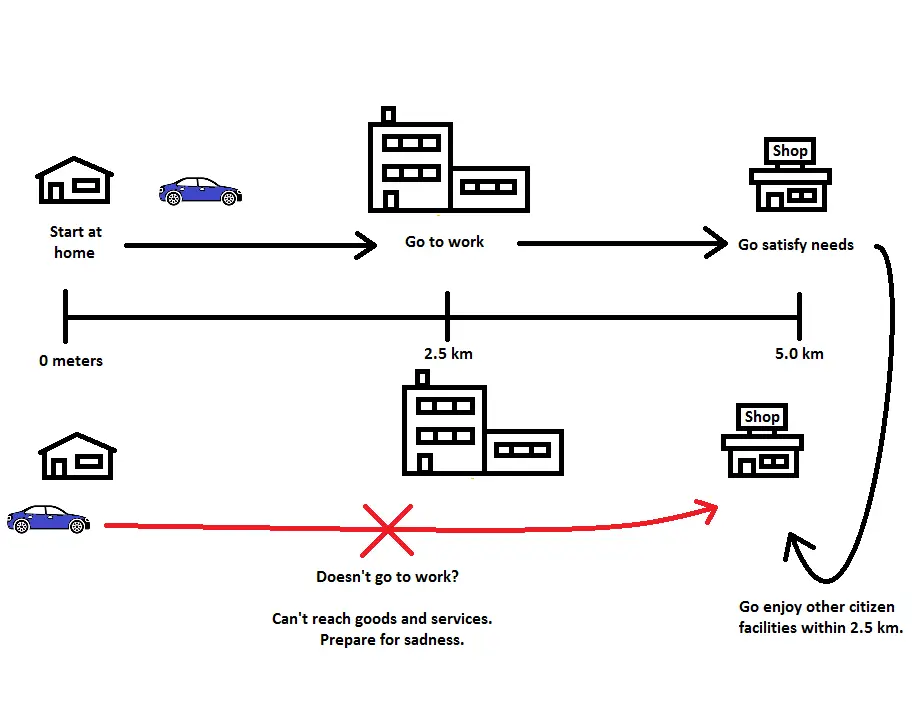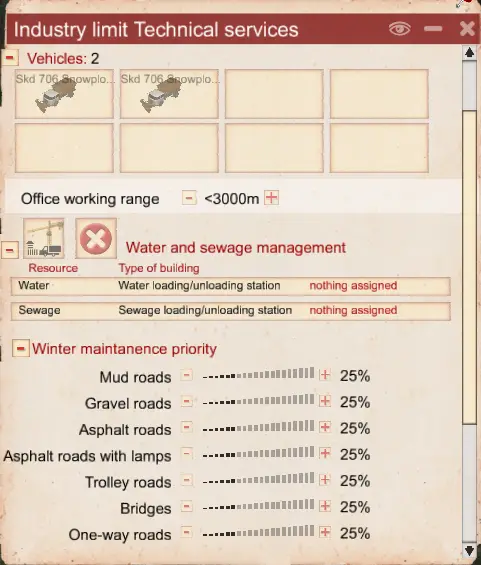A guide explaining mechanics of personal cars. I promise there will be no Oprah references.
Voorwoord
This guide goes pretty in depth, so feel free to skip around to whatever interests you. Most of this guide focuses on revealing the mechanics of personal cars for easier planning.
Inexperienced players should play a few republics first, and get some experience before thinking of widespread car distribution. There are many aspects of the game you need to know before tackling the widespread distribution of personal cars; it is not a beginner subject in this game.
This guide is current for version 0.8.7.12
Why Bother?
Personal cars are often derided in this game as being a useless, if prestigious, addition for your Republic due to its traffic issues, low range, somewhat high money/resource cost, and seemingly low benefits, but they are, like many features in this game, misunderstood/unknown to most players. Personal cars are another tool at your disposal, which while not suited for everything, they do have advantages unique to them and a niche of their own that players may find useful, especially with some tricks you can use to alleviate their issues.
Generally speaking, personal cars are a great supplement to public transportation and their chief benefits are maximizing the loyalty and free time of citizens, but they have a few other uses too. They are not for beginners due to their many mechanics and problems a player will face when using them.
I have no doubt this will be heavily contested, but below are what I see as the advantages and disadvantages of cars.
- Car owners are more loyal, due to both having a car and by potentially having more free time for consuming radio/TV propaganda programs.
- Car owners have the highest loyalty cap, which in turn means car owners will have the highest productivity cap.
- Car owners are much less likely to miss needs due to running out of free time. This is because car owners waste less of their free time and don’t wait at stations if they can help it.
- Cars can be used to ensure workers’ needs are met when their work time is very long due to travel time (working longer multiplies need amounts, which can be hard to satisfy with public transportation).
- Cars can be a good option for ensuring remote workplaces are not empty thanks to their higher frequency and higher speeds.
- Flexibility – Roads can serve generally any number of cars with the right planning as there are many options available to suit the situation and budget, and if you need to alter your road network, you have many tools to do it easily.
- Cars allocate worker/passenger slots automatically and with less waste of man-hours than public transport typically can.
- Car owners do not need to wait for public transit and thus will not go home after waiting an hour at a station.
- Car owners can still use public transportation if they can’t get a job or meet their need(S) within their car’s range. This means you could have them commute to work by public transportation and then drive to satisfy their free time needs.
- Cars are a great way to compensate for the multiplied free time needs of citizens with maximized work times (which is done by maximizing their travel time to work with public transportation).
- Personal cars have a somewhat limited range of 2.5 km from its residential parking lot to other parking lots, but there is a way to reliably get car owners to drive to 7.5 km away from home for certain needs.
- Traffic Jams are very easy to cause in this game, which can cause severe problems in your Republic. Some methods are discussed for maximizing car throughput and dealing with traffic jams.
- Road systems become much more complex and expensive than public transportation when trying to design for capacities over several hundred cars.
- Personal cars can be taxing on your fuel refineries and will require quite a few gas stations. You will also need a logistic network for supplying gas stations with fuel.
- Large numbers of citizens driving personal cars will tank your frame rate long before population normally would.
- Personal cars can be expensive to buy/produce and fuel for many citizens, especially for a young Republic.
- Not everyone can use personal cars; children and young adults must walk or take public transportation to reliably attend school (parents can irregularly drive them to school). Kindergartens must also be within walking range.
- Due to the way car owners reserve parking spaces (not for residences, maar voor “traveling to this parking lot”), you need to have roughly 2 naar 3 times the number of parking lot spots as you want cars to visit a service building. This can be mitigated somewhat by connecting multiple buildings to the same parking lots, but you will be seeing a lot of half empty lots.
Aspects of cars that may be good or bad depending on the situation.
- Sometimes car owners will have some or even all their free time needs satisfied right after leaving work. This can be nice because they will spend more or all of their free time at home consuming radio and TV programs, but this can also disrupt the range extensions.
- Car owners can take their children to school, but this happens irregularly so the child will take longer to get a basic education if not taken to school by other means (school bus). This may be a good thing as you’ll get more opportunities to fill hostels/dorms up and have graduates move to new towns/cities without the happiness penalty Citizens will now move out into any free flat on them map. Dorm/hostel manipulation is no longer needed for this.
- Citizens will prefer driving to walking, and can thus waste time and fuel when walking would have sufficed, but this may also preserve their free time. Proper planning can cause or prevent this as desired.
Management Tools
The game offers many tools for managing personal cars. Some of these are self-explanatory; the others are discussed below:
- Overlays – Kinda useful for watching multiple elements in your republic at once.
- The List of vehicles and buildings – Probably the most important menu for finding and monitoring cars; unfortunately limited in some regards.
- List of lines – A menu that compiles all the road lines in your republic into a single list. Useful for managing car deliveries.
- Population Statistics – A menu that shows the number of car owners in your republic. You can view this number over time here.
- Residential building menus – These menus let you look at just the car owners and their stats as a group in the building at once. Helaas, there is no way to see citizens without cars as a group.
- Vehicle menus – These show more accurate information than the List of vehicles and buildings, as well as the current state of the vehicle (snelheid, fuel remaining, actual weight, enz.).
- Citizen menu – You can see if a citizen owns a car by looking under where their home is listed, and if they do, there will be a button that will bring up the car’s menu. Their status as a car owner will only be displayed if they have a car. You can also see how long they have been driving their car here too.
- Parking lot menus – These shows the status of ownership for cars and parking spaces. You also set the requirements for owning a car here.
- Place crossroad tools – Aside from their normal function, they also display all the current settings you have for various road intersections.
- Place road sign – Aside from placing/removing signs, selecting this also shows all the current signs placed.
- Accounting Offices – Useful for seeing how much fuel an area uses since its creation, which can help you fine tune fuel logistics for those areas.
- Notifications – The game will alert you of traffic jams (if you have them enabled), which matter a lot more with personal cars on the road.
There are a few overlays that may prove useful:
- Car Owners – Under ‘Citizens living preferences’, this overlay shows the number of car owners living in a building. If you know the capacity of the building, you can see at a glance if residential buildings have the potential for more car owners or if a building is missing cars.
- Citizens current location tab – a tab under overlays with options for showing the location of different types of citizens. This is nice for seeing the utilization of buses and cars, and where university vs. basic education citizens are going in their cars to work. Also useful for finding children who were or are being taken to school by their parents (see the Car Owner’s Life section for more info).
- Road vehicles tab – another tab where you can select types of road vehicles. This can be nice for finding where your fire trucks and ambulances are stuck, but not so much for looking at cars on the road due to the large icon size.
- Buildings tab – You can use this overlay to find where your car dealerships are at if you forget or see where parking lots are at. Not that useful really.
There is a check box option in the overlay menu to keep the overlay on without the menu open.
List of vehicles and buildings Tool
This handy UI has two modes, both of which are very useful not just for personal cars, but also every other vehicle in the game. This guide will focus on road vehicles, but some other types of vehicles are discussed.
The first mode lists all the vehicles in your republic with their status and some stats.
.
From here you can sort vehicles by type and sub types (road vehicles, and personal cars, Bijvoorbeeld). You can sort further by the following categories:
- Brand – Really, this is whatever the name of the vehicle is, which defaults to the vehicle’s brand/model name. You could rename a car “Lightning McQueen” and that’s how it will show up here.
If you press Ctrl – B, these names will be replaced by the vehicles exact coordinates, which is nice for testing vehicles because you have exact positions, but since you can just click on the vehicle’s entry to open its menu, this won’t be useful for most occasions.
- Type – The type of the vehicle. This is nice for looking at a category of vehicles at once, or to locate a missing truck or mechanism you cannot find.
- Building/Next Stop – this will display the current destination of a moving vehicle or where it is currently stored at, with three exceptions:
- Parked “gebruikt” personal cars will always display the parking lot that their residency parking reservation is at, even if unowned and sitting in another lot. Personal cars will show an actual destination if their owners are driving them somewhere.
- Vehicles belonging to a Construction Office or Distribution Office will always display their office’s name.
- Vehicles being transported on another vehicle will display nothing.
This category is much more useful if you rename the places and parking lots in your republic so a clutter of useless words doesn’t fill the screen. The main reason is that you cannot click on the destination to show you where it is. The best option other than renaming, is to open the vehicle’s menu, enable cheats, en druk op i to show you the coordinates of the stops/nodes it makes. Pressing C (also needs cheats enabled) will show you your mouse cursor’s coordinates at the top left of the screen, and you can use that to find wherever this mystery destination is at.
- Length – Currently this is the only place in the game to find out how long some of the vehicles are. Length matters for some vehicles, but not others:
- Road vehicles – Shorter lengths are better for intersection throughput and allow more cars to be transported by other vehicles. Usually doesn’t matter.
- Boats – Determines the docks it can dock at. Ships that are too long cannot visit some of the smaller docks.
- Trains – Maximum train lengths are limited by depot/distribution-office, so shorter engines/wagons means more can fit into a given length. Train lengths are also useful for some semaphore tricks.
- Airplanes – Only affects time to get off the runway onto the tarmac (this limits airport throughput). Width determines minimum pad size, but is only displayed in their menu and popups.
- Helicopters – Doesn’t matter at all.
- Weight/Cargo – This shows a vehicle’s unloaded weight with its cargo’s weight in ( ). Helaas, the game will round vehicle and cargo weights to the first decimal, so you will need to open a vehicle’s menu to determine its exact weight. Fuel weighs nothing once in a vehicle’s fuel tank.
- Snelheid – Shows how fast a vehicle is going. Vehicles that are being transported on other vehicles will show a speed of zero.
- Fuel/kW – Shows how much fuel is left in the vehicle as a percentage of its full tank, dat is 5.2 liter (of 0.0052 tons) times engine size in kW. This is nice for finding where vehicles run out of fuel at, and monitoring the fuel levels of cars in an area.
- Engine – Displays the vehicle’s engine, which can be used to calculate the weight/liters of fuel left in a vehicles. Some airplanes list their engine in kN (like the Tu-144), but it will be displayed in kW here (blijkbaar 1 kN = 100 kW).
- Value – This displays the amount of money you get for selling a used vehicle, which is about 70% of what a new vehicle will get/cost you. You can multiple the displayed value by 1.428 to get a close estimate of what a new vehicle will sell for.
This second mode shows you all of the vehicles in the game, and let’s you preview some of their attributes. This mode is accessed by checking the box in the top right of the menu, naast “Types availability.”
.
Like the previous mode, you can view the brand, gewicht, engine rating, and resale value of each vehicle, but speed and length will be unavailable to you. You do get two new categories though: years of availability, and country of origin. The number of passengers will now also be displayed under weight/cargo as a number with a p on it, such as 1t (4P).
Summary of Basic Car Limits & Mechanics
This section covers the basic limitations of personal car usage that you should be aware of when planning for personal car usage. Some of these overlap with other types of vehicles.
New cars are made at your vehicle production lines, and are the only cars that can be sold at the border for full price and transported on other vehicles. New cars become “old” cars if they are taken/reassigned to a depot/parking-lot or if a dealership puts them up for sale. Cars you buy are always old cars. Old cars can be sold, but only at for 70% of what a new car is worth, regardless if they were never owned or even driven. You will pay full price for “old” auto's, but there is at least no “delivery charge” for vehicles either.
Only the owner of the car will drive the car, and only their children may ride with them (and then only to school). The only other way to get multiple people into a car is to treat it like a bus and assign it to a line.
All road vehicles cannot turn around whenever they want. They can only turn around at nodes in the road (the purple dots seen when pressing h). These nodes form at intersections with other roads or footpaths, where signs in the road have been placed, where two different road types where connected. Changing a road may merge segments together, but you can also get rid of nodes by placing and removing signs on the node (this may not work if vehicles are present on either segment of the node).
When citizens consider using their cars for whatever reason (find jobs, satisfy needs) they will only consider buildings that can actually be reached from parking lots that are < 2.5 km from whatever parking lot their car is parked at (prohibitive signs or having to make a U-turn are included in this calculation). There is a way around this for free time needs that is discussed later, but parking lots for workplaces unfortunately can never be further than 2.5 km from where a citizen parks their car when at their home.
When a car needs to refuel, it will continue on its route until it finds a gas station it can reach < 2.0 km by road away (not as the bird flies), upon which it will divert from its route and go to the gas station, refuel, and then resume its journey to wherever. Dit 2 km range includes the distance that a car must go to turn around too. If the car reaches zero fuel, and they are further away than 2 km from a fuel station, they will come to a stop on the road and block traffic.
Similar to citizens using public transportation, car owners will drive up to 4 “uur” before teleporting home (their car will also teleport to its residence reserved spot), and they will also spend more than 5 “uur” a day traveling for a minor happiness debuff. Due to the range limit for personal cars, citizens should only teleport home after 4 “uur” if they are stuck in heavy traffic or a traffic jam has occurred.
Helaas, if a car owner’s free time ends before getting home, they will not teleport, but drive home before driving to work (gotta put those groceries in the fridge).
Cars will reserve parking spaces in two ways. The first type of reservation a car will make is a “thuis” reservering, which prevents other cars from parking in that spot and it determines where the ownership of the car is assigned, including if its owner dies or moves, regardless of the car’s current position (citizens can die at work or when shopping). Unowned cars will not make this reservation until actually reaching the parking lot, but owned cars do when they are driven from the dealership to home. Cars parked in this “thuis” spot are marked with a white P on a blue square in the parking lot’s menu, while abandoned/unowned cars are marked with a person’s silhouette with a red X.
The second type of reservation is a “visitation” reservering, which car owners will make when they want to visit a building (for work or errands) near the parking lot. Before starting to drive, car owners will check the parking lots near the building they want to visit and reserve a free spot if they find one, and then they will walk to their car and drive to it. This reservation prevents other car owners from visiting that parking lot spot. Once they finish their business/job, car owners will normally walk back to their car and start driving to their next destination, which removes this reservation and allows other car owners to reserve the spot and travel to it. This reservation can be tracked in the parking lot menu under the “Cars heading to this parking lot” header (cars assigned to a parking lot via the “change depot/workplace” button will not show up here because they have no owner).
Both types of reservations can cause problems if not accounted for. Citizens will happily claim parking meant for shoppers, patients, werknemers, enz. and block them from visiting the facility by car, while someone reserving a slot from far away will prevent other car users from using that slot, which reduces the effective size of the parking lot. Methods to designate parking for specific buildings are discussed later in the guide, maar voor “visitation” reservations, you should build 2 naar 3 times the visitor and worker capacity of the buildings you want parking for; anders, the building will be underutilized as it waits for patrons/workers to drive there (walkers and public transportation can take up the rest of the building slots however).
Citizens will drive their car to a parking lot with the intent of walking to a station for public transportation. They will board vehicles, but only if they can walk to their car from the station/workplace where the public transportation can take them; met andere woorden, there is no point to doing it because destinations must be so close that citizens may as well just walk to them. Workers will also board vehicles that go straight to buildings they can work at, but upon arriving they and their car will teleport home.
For now though, be aware that while car owners will prefer to drive to work and walk to a station, they can drive to parking lots within walking distance to stations. Try to make stations closer to their homes than the parking lots they would drive to.
Citizens will not take their cars with them if you forcibly move them to a new home, even if there are open nearby parking lots they could reach. You can however, move the cars (Change depot or workplace button) to their new home’s parking lots, where they will automatically assume ownership again (provided they meet the parking lot ownership settings).
“Confused” Cars will continue to be confused until they both have their pathing logic fixed (d.w.z. find a path to their destination) and they reach a node in the road.
Personal Cars that cannot find a way home will wander around confused until their 4 hour travel limit elapses, upon which they teleport home.
Sometimes vehicles will suddenly stop and have to accelerate back up to speed. This can happen when faster vehicles pass slower vehicles (personal cars passing trucks and buses is the usual cause), when multiple cars are going through an intersection (faster cars seem more liable, especially with traffic), or when trying to enter some buildings.
Building one way roads and “no passing” signs can help stop the passing stumbling, but intersections and buildings do not have a good fix.
Potential Car Owners
Not all citizens can use cars due to restrictions that the game sets and due to the eligibility settings you enact.
No matter what settings you specify at a parking lot or dealership, none of the following citizens can use cars, so plan ahead for them if you choose to rely primarily on cars.
- Children – Children need to go to school and university, but cannot drive. Ensure they are within walking distance or provide public transportation. Parents can take their kids to school (if all the conditions are met), but not very reliably; their children will be miss a lot of class and take a long time to get a basic education.
- Babies – Kindergartens cannot take care of babies from homes that are not within walking distance. Parents who cannot access kindergartens by foot will have to stay home from work and take care of the baby.
- Injured people – Once a citizen’s health falls too low, they cannot leave their home. Ensure they are within range of an ambulance van/helicopter (1.7 km by road and 3 km as the bird flies, respectievelijk), or accept that they will die.
- 21+ year olds still living with parents – They cannot get cars, even if they can reach parking lots with unreserved spots. Not a big deal though, they just act like children do (go to school and mooch off parent) until a flat opens up somewhere or they escape.
- 21+ year old students living in Hostels/Dorms – They cannot get cars because they don’t have their own flat, so you must provide them public transportation or footpaths.
- Uneducated citizens – An education level of at least basic is required for car ownership. You will need to have them walk or ride to school (and whatever service buildings they need) before they can get a car.
- Tourists – While not your citizens, they do need to get around, so you will need public transportation or footpaths for them too.
There are two to three sets of requirements citizens must meet to own a car.
The first set of which is:
- Do they have their own flat?
- Do they have at least a basic level of education?
- Can they walk from their home to a parking lot* with either:
- An unreserved, empty parking spot, of:
- An unowned car sitting in the lot (which they can take ownership of)?
* They will teleport home if unable to walk from the parking lot to their home.
The second set of requirements is the criteria you set for who can own a car. There are three categories the game gives you options for, each with different options:
- Onderwijs – Regardless of settings, citizens require at least a basic education to own a car.
- Prefer university education
- Only university education
- Basic or higher
- Age – Citizens must be at least 21 years old to own a car (only adults get flats).
- Prefer younger
- Alleen < 30
- Alleen < 40
- Any
- Government Loyalty – If a citizen’s loyalty is unknown, this setting is ignored.
- Prefer higher
- > 75%
- > 50%
- Any
Keep in mind that these settings do not determine who can park at a given parking lot, but who can assume ownership of an unowned car there.
Eligibility is individually set at each dealership and parking lot, which is nice if you want specific people to own cars in certain areas, but sucks if you want to universally set requirements for all parking lots and dealerships at once. The cars of dead citizens are reassigned based on the car’s home parking lot’s settings.
When citizens will die, their car will sit in whatever parking lot it was at when they died, until someone meets the requirements for its home parking lot (not the settings of the parking lot where it currently resides at). You may need to set each parking lot if the default requirements don’t fit the requirements you set at the dealership.
The third and final set of requirements has to deal with dealerships, which have two additional requirements for citizens to get cars from them:
- The citizen’s home is < 2.4 km* from the dealership**.
- The parking lot the citizen wants to park their new car at is < 2.5 km* from the dealership. You can use the the “View reachable parking lots” button to see if parking lots are within range.
*Both of which are measured along the road and not as the bird flies (for the measurement tool, go by “Ground distance,” niet “Air distance”).
**This is just a requirement range; citizens will only go to a dealership to work or drive their new car home. They will never spend their free time waiting in line there, and they will teleport to the dealership to drive their new car home; you will never need public transportation to take citizens on their free time to a dealership.Dealerships also offer the option of “Occupancy of car parks,” which will limit distribution depending on how full the parking lots that citizens have access to are. If you don’t restrict parking for specific uses or residences (discussed later), you may want to use this option.
Sourcing and Distributing Cars
Once you have figured out who may own a car in your republic, you then must decide how you will get and deliver cars to them.
Provided they meet the requirements, citizens can obtain cars by two ways: at a dealership, or by claiming an unowned car.
- Parking Lot Claiming Method:
-
- Voorwaarden: Citizen meets the requirements and a car is in the parking lot and is unowned (as marked by the crossed out black silhouette on the car’s icon).
- At the beginning of their work shift or their free time (whichever happens first), the citizen will assume ownership of the car.
- Dealership Method
-
- Voorwaarden: There are citizens nearby who meet all three sets of requirements, and the dealership has a car to assign and at least one worker.
- When the ‘progress in selling next car’ bar fills, the first citizen “in line” will be teleported to the dealership where they will drive their new car home.
- The citizen will then start their free time (you will lose the remainder of their work shift).
Dealership and parking lot. Note the unowned car in the big parking lot.
The main purpose of dealerships is to automate the assignment of cars to citizens so you don’t have to manage moving cars to parking lots. All you have to do is buy/make cars and get them to the dealership; with a car factory, you can completely automate this process. The slow assignment speed is good for preventing traffic jams caused by a large influx of cars onto your roads, but supplying several hundred cars may take over a month to do.
alternatief, you can decide to fill a parking lot with unowned cars and allow citizens living nearby to take ownership of them at the start of their next work shift or free time. This method is much faster as citizens are not limited to the slow dealership speed, but in return you have to deal with a lot more logistical headaches, especially with cosmonaut rules. Getting cars to parking lots requires your time to relocate them as does organizing trucking lines to fill parking lots. Simply relocating cars by the “Change workplace/depot of all vehicles” will result in a bug (zie hieronder) and can cause a huge influx of cars into your road network.
You really only have a couple methods for getting cars:
- Buying cars – More expensive per car, but easier to do and much cheaper than a factory.
- Producing cars – Needs costly investments, but gives a distribution advantage and income.
The way you move cars to dealerships and parking lots will depend mostly on whether you are buying or producing your own cars.
Distribution Methods:
- Buy the cars at the parking lot or dealership – Easiest method, but against cosmonaut rules.
- Relocate cars by assignment – You can move cars between parking lots, depots, and dealerships with the “Change depot or workplace” commands (beware of the bug discussed below). Cars can be bought and relocated by cosmonaut rules this way, but there is a potential for traffic jams to occur if you relocate more cars than your roads can handle; remember that these cars will not teleport home after 4 hrs of travel and may block critical roads indefinitely.
- Build cars and move them as cargo – This method can be used to prevent traffic jams and can automate dealership’s supply of cars, but unless trains or boats are available, you will be limited by the capacities of trucks, which may have terrible throughput depending on the size of cars you are using.
- Build and move cars as cargo to a main storage area, then relocate to parking lots – Basically combine the last two above methods to avoid traffic jams.
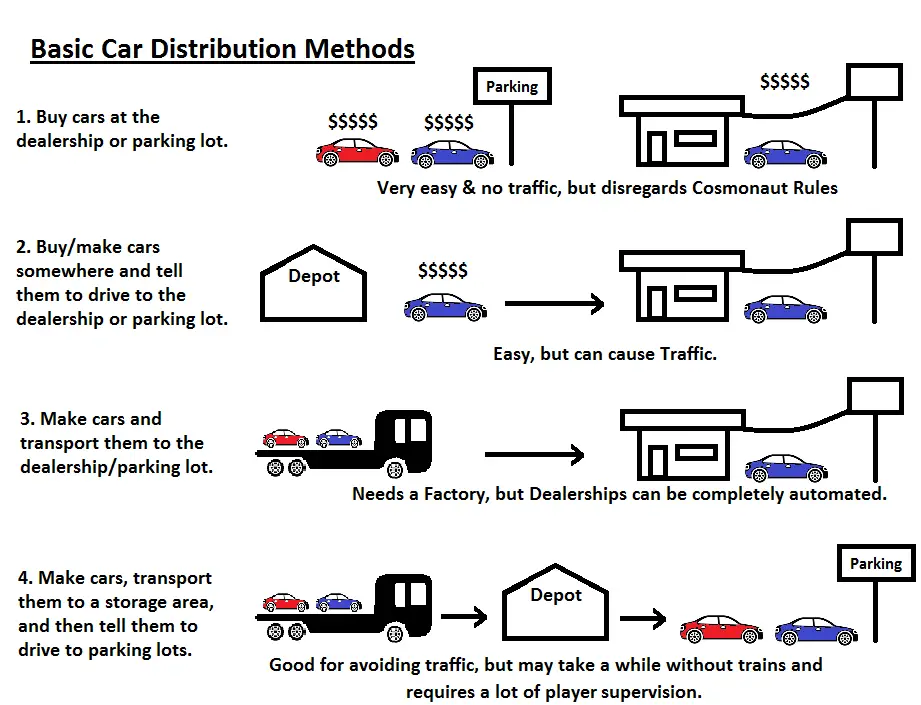
.
Some tricks to minimize the amount of clicking and supervising you have to do for car distribution:
-
Single Shot Lines
If you include a depot in a vehicle line, it will go through all of the line’s stops once before going to the depot, where it will wait for you to start the line again. You can use this to set a line for a truck to fill a parking lot without having to worry about it wasting fuel due to running trips after the parking lot is full.
The number of runs you must enter is: Capacity of parking lot / by number of cars loaded per truck (which will vary). Beware that any excess cars will be dumped into the depot and lose their new status and car owners parking in a lot can block trucks from unloading; ensure trucks have “wait until unloaded” checked or block cars from the parking lot with signs. 10 car example:
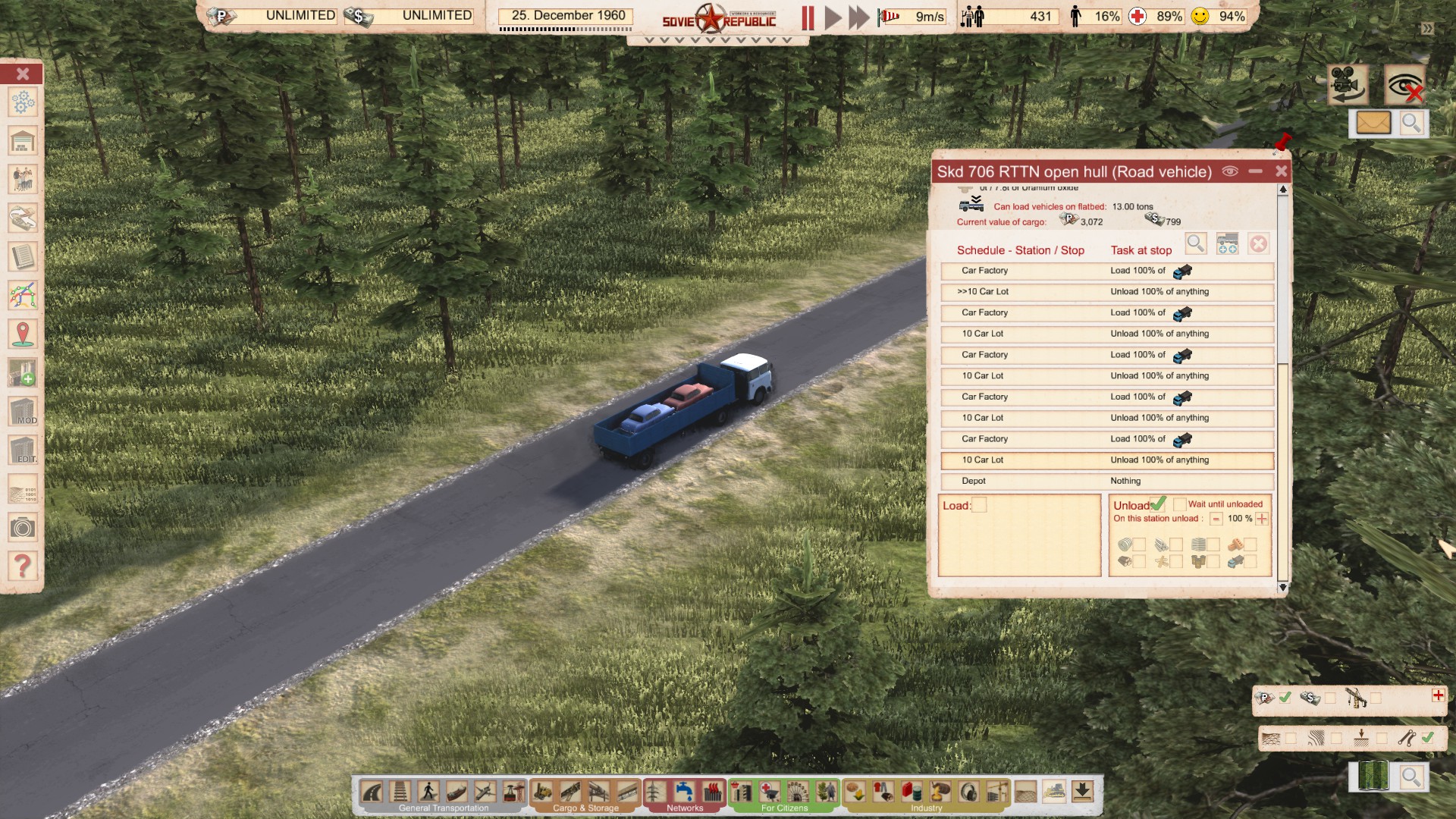
. -
Truck Line Multiplication
When using the single shot line trick, you can cut down the number of runs you need to enter by having more trucks on the line. The new formula becomes: # of Runs = Capacity of parking lots / (# of trucks x truck capacity). If you get a decimal number, round it up to the next digit (examples: 1.25 -> 2, 1.75 -> 2), enter that many runs into the line, and copy it to all the trucks. Then just subtract runs from one or more trucks until the proper number of cars is programmed for moving.
- 30 car example:
-
- 30 / (8 X 2) = ~2. 2 runs x 8 trucks x 2 cars per truck = 32 auto's. 1 run = 2 auto's, so get rid of one run from a truck.
-
Filling Multiple Parking Lots
You can also enter multiple parking lots into a single use line, which is convenient for filling multiple parking lots with minimal supervision. There are a few ways which each have their own pros and cons:
- Wait on last lot – This is a quick and easy method, but it wastes some fuel/time going through all the parking lots so try to only include parking lots that are near each other. Trucks will also block the entrance so ensure you have traffic jam alerts on in case you forget:
- Make a line with the factory and all the parking lots you want filled
(F -> A -> B -> C, enz.). Ensure that only the last stop has “Wait until unloaded” checked, and then start the truck. - When the parking lots are full, the truck will wait at the last parking lot for you to send it to the depot or the vehicle storage space. Renaming the truck makes it easy to keep track of it in the vehicle list tab.
- Make a line with the factory and all the parking lots you want filled
- Combined Single Run – Essentially you are combining multiple single shot lines to different parking lots into a single line. This lets you fill several parking lots over time without supervision. This method gets a lot more complicated when multiple trucks are involved, so try to keep it to parking lots of the same size.
- Staging and Transfer – This method involves filling up a parking lot or depot with cars and then transferring all the cars to other lots. Very easy to implement, but it requires some supervision and you need to be careful not to overfill parking lots (see the double parking bug/exploit below). To do it:
- Build a parking lot and isolate it from pedestrians and personal cars via signs or build a depot.
- Set a line with only two stops: the factory and the above parking lot or depot. Ensure “wait until unloaded” is checked for the parking lot.
- When the depot or parking lot is full, je kunt de “Change workplace/depot for all vehicles” button to move cars into a parking lot for citizen use. The truck(S) on the line will then refill the parking lot, and you can fill another parking lot.
- Wait on last lot – This is a quick and easy method, but it wastes some fuel/time going through all the parking lots so try to only include parking lots that are near each other. Trucks will also block the entrance so ensure you have traffic jam alerts on in case you forget:
Double Parking Bug/Exploit
There is a bug/exploit where you can send more cars to a parking lot than it should be able to hold.
Until a parking lot has no more empty, unreserved spots, you can keep using the “Change depot/workplace” commands to assign more cars to it (dealerships and depots are protected from this, and trucks will not unload more cars than a parking lot can hold). It is possible to assign all the cars in a car factory to the 6 car parking lot.
This bug will cause a traffic jam until people take ownership of the cars and start using them. Eventually car owners will just double park at the entrance which will not impede car access any more, but unowned cars will block any road they wait on indefinitely because they will not teleport anywhere after 4 HRS.
This bug will also hide problems such as unused cars, because only the prescribed number of vehicles are displayed in the menu.
A Car Owner’s Life
This section talks about how a citizen goes about his/her day when they own a car. Keep in mind that a citizen will only drive to places reachable on foot from parking lots that are < 2.5 km from wherever their car is currently parked.
At the start of their work shift, car owners will be at home and:
- Look for a job they can reach with their car.
- If they find one, they may also take their child to school (zie hieronder), which is treated like a side trip, similar to refueling.
- If they didn’t find a job, they will go to a station like a citizen normally would* if they had no car and rely on public transportation to get a job. If no station is nearby, they will give up for the day and start their free time.
- If they still didn’t get a job (waited at station too long, or spent too much time traveling), they will teleport home and wait for their work shift to end.
- After work, their free time shift begins, and they will attempt to drive to a place to sate a need:
- If they find a place, they will drive there, park, and enter the building.
- Zo niet, they will drive home (if not there already), and once there, look again for any buildings that may satisfy their needs.
- If they still cannot find a building to satisfy their need, they will walk to a station* and attempt to meet their needs through public transportation.
- Once all needs are met, or if the citizen has given up on looking, they will stay at home and listen to the radio or watch TV until their free time ends and their work shift begins.
*Car owners will also drive to parking lots for the purpose of waiting at a station, but because car owners will immediately teleport home if they are at a building from which they cannot reach their car, this effectively wastes their time and possibly causes them to miss needs and work. Ensure the closest stations car owners can reach are near their home, where they can walk to should they need public transportation.
Having a car changes a citizen’s day in a few major ways:
- Car owners do not automatically teleport home after work, but instead walk to their car and drive from there.
- Car owners, like all citizens, can walk from one building to another to meet multiple free time needs (Bijvoorbeeld; walk from a station, to a grocery, and then to a hospital), but a car owner who parked by one building will visit other buildings by foot so long as they can still walk back to their car.
- The free time of all citizens is spent when waiting at a station, visiting a building for a need, and walking in between buildings (traveling in a vehicle pauses the free time counter), but car owners will prefer using their car and so will not spend free time wait at a station unless they have to.
- Car owners who are not home when their free time ends will not teleport home; they must drive home instead before driving to work, even if that means passing the place they would have worked at. Car owners will still teleport home if they exceed their 4 hour limit on traveling in a vehicle.
- There is no way to prioritize jobs that are reachable by cars. Therefore when relying on cars to staff positions, you must be careful to ensure that worker demand does not exceed the labor pool of car owners, or critical jobs may be ignored; Echter, if you combine cars with public transport, citizens will prefer jobs they can reach with cars and will try to fill those jobs first.
- Sometimes car owners will leave their work with some or even all of their needs fulfilled partially or totally. They will not attempt to fill a need unless it is below 50% satisfaction but needs with over 50% satisfaction will not count as unsatisfied.
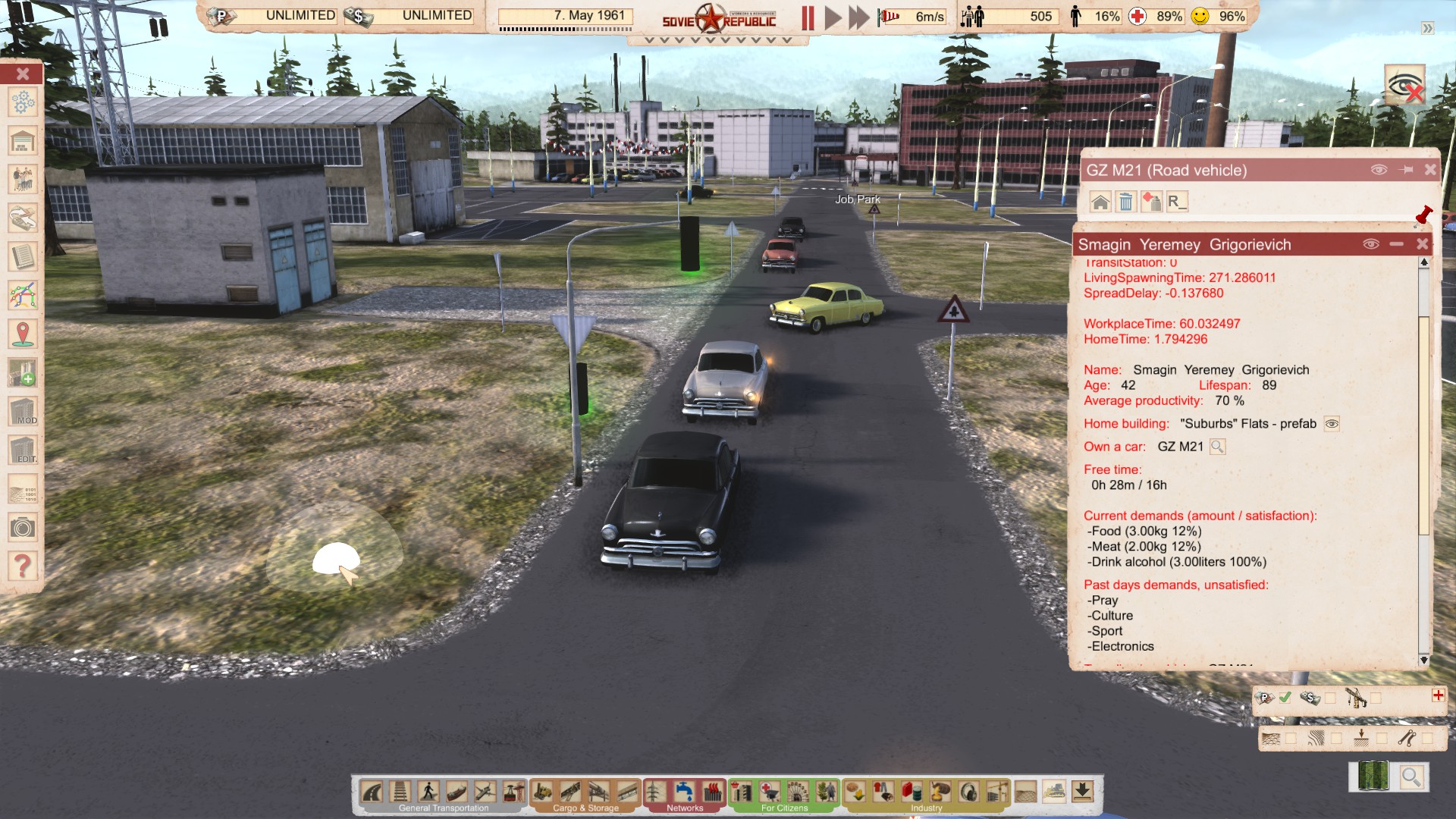
Sometimes this is a little funny.
To get parents to drive their children to school, you must fulfill these conditions:
- Have a functioning school with a parking lot < 2.5 km away from their residential parking lot. The school parking lot must have a free slot they can reserve.
- Have a workplace with a parking lot < 2.5 km from the residential parking lot. This workplace can also be the school.
- The parent starts their work shift when their child is at home and on their “school time”.
I am unsure if the child must be < 21 jaren oud. Momenteel 21+ year olds who still live with their parents act like school children do, so it may be possible for their parents to take them to university (or school, if they didn’t get it for some reason.)
Parent taking their child to school.
Parents do not need a university education to take their children to school unless you make that a requirement for owning a car. Parents will also not drive their babies to a kindergarten, nor will they take their critically ill children to a hospital.
If being driven to school, children will be “working” at the parking lot their parents park at. If you use the overlay under “current citizen location” tab and select the “children age 7-21” overlay, you can see how many children are being, or were, taken to school by the number of children icons on various parking lots. Once they finish their school shift, they will stop being counted at the parking lot.
Loyalty Effects of Cars
Cars are perhaps the final improvement you should make for your citizens as it is the most complicated by far, but it can provide the final boost needed to achieve very high productivity. Owning a car has two main effects on a citizen’s loyalty, both of which are applied over time.
The first is simple in that just having a car gives a loyalty boost. According to the devs:
Personal cars will be the tool you will need when you do not have active broadcast of propaganda. You can give your most loyal workers cars and thus keep or raise their loyalty slightly. The better and faster the car is the more impact on loyalty it has.
Helaas, there doesn’t appear to be any information on what “better” is; it could be model years, bigger engines, higher car values, larger car sizes (length x width, as a metric for interior room size), a combination of those factors, or something else entirely. The tags in a vehicle’s .ini file don’t reveal anything either, so for now if you want to maximize the loyalty gain, try to get cars that are close to the T613’s top speed of 170 km/hr.
Testing by some players seems to reveal that citizens must be in their car to receive the loyalty boost, which would mean travel time in the car is important for the loyalty boost. I haven’t tested this, but the way monuments work would imply that is the case.
Actual measurement of a car’s effect is also hard to measure, but it does seem to elevate loyalty over time. Supposedly the maximum total boost from car ownership is around 10-20% depending on citizen reaction levels, so you will always need at least monuments as well (build them everywhere, especially near homes and work/free-time places; citizens always benefit from them when they are within the radius). This is also taken from the Developers’ statement:
Personal cars can now give you maximum 75-85% loyalty based on the unsatisfied citizens reaction level and quality of the car. Radio Broadcast can help you gain up to 70-80% loyalty for citizens without personal cars and 80-90% loyalty for those with personal cars. The only way how to gain 100% loyalty will be TV broadcasting and it will be possible only for citizens with personal cars as other will be limited to range of 80-90%. The boost for citizens’ loyalty from monuments is now 40-50% based on difficulty settings and the effect of monuments was decreased by 20%.
The second effect on loyalty is more subtle, but probably adds as much loyalty as just having the car does. Essentially car owners tend to have more free time for radio and TV because they waste less of their free time:
- Car owners will avoid spending their free time waiting at stations, while regular citizens who wait at stations will lose hours of their free time on nothing (‘Waiting on a platform’ voor “one hour” can result in “4.5 uur” or more of free time lost).
- Citizens will also wait in their home during the start of their free time (after their spread delay timer ends) and use up to an hour of their free time before leaving to walk to a citizen facility or a station, but car owners can skip this time if they start their errands from their workplace. They simply walk to their car from work and start traveling right away (all citizens, including car owners, must wait again if they both go/teleport home, and have another need they want to satisfy).
These free time advantages gives them much more time to spend at home watching TV or listening to the radio. Instead of having maybe one or two hours a day of spare free time, car owners usually have over 8 hours a day to listen to the radio.
Let op de 5+ hr travel time, and need satisfaction percentage; most of her free time was spent shopping, yet she still has over 8 hours of time left to enjoy quality radio/TV
propagandaprograms.
You can achieve similar results with facilities within walking distance, but keep in mind that walking eats up a lot of time too and severely limits the use of facilities. If you make your citizens enjoy a healthy long distance walking life, you might find them running low on time too.
To maximize free time for radio/TV and their resultant loyalty gains, you must:
- Minimize travel time to work. With less time spent traveling to work, your citizens will spend less time at work, meaning their needs will be in smaller amounts/time which in turn need less free time to satisfy.
Cars have an advantage thanks to not waiting at stations and traveling at a pretty good speed (trains and aircraft do go faster, but stopping at multiple stations reduces the average speed), but it is possible to make public transportation quicker, though it may not be very practical or cheap.
- Minimize time spent waiting at stations during free time. On top of waiting up to an hour of free time before leaving their home, citizens may also need to wait at a station to take them to where they can satisfy their need. This can easily add up to a third of their free time before satisfying needs even enters the picture. Car owners can skip both if they can drive from work to the citizen facilities they need to meet their needs.
- Minimize walking distances – Citizens spend free time and travel time walking between buildings (except when leaving the house to go work somewhere. Other walks on the way to work still count though, such as from a station to a workplace), so you want to have the shortest footpaths between residences, citizen facilities, jobs, and their parking lots.
Reserving Parking Spaces
One problem with personal cars is the tendency of citizens to reserve all of the spots in parking lots meant for workers or citizens visiting a building in their free time. This would lead to many citizens having cars, but being unable to use them because there is no parking available for work or free time errands.
Here are four methods to reserve parking for workers and free time visitors, half of which rely on the requirement for citizens to be able to reach a parking lot from their home in order to reserve a space there.
- Optie 1: Build outside of the walking range from a residential building (400 meter afstand, as measured along the roads/footpaths, is always sufficient). This is the easiest method and you’ll probably be doing it anyway for polluting industries that homes should be nowhere near.
- Optie 2: Isolate parking lots to specific buildings with road signs and selective footpath connections. This method requires a short distance to place the road signs and extra space for footpaths (which may need temporary access to allow construction vehicle access).
- Optie 3: Don’t use a dealership and manually fill the parking lots you want citizens to reserve their residency spots at with cars. Citizens do not take their cars with them when changing residences, so you don’t need to worry about them filling other parking lots. This method is not perfect though, because you also lose the automation the dealership offers and you must spend a lot of time and supervision moving cars.
- Optie 4: Use the dealership with the occupancy setting prohibiting distribution of cars to parking lots with >50% occupancy (reservering). This should ensure parking lots have the space, but not all spaces will be within walking distance of various citizen facilities.
Citizens will also die and leave their car wherever it was when they died unowned, but the car’s residency parking reservation will remain at the car’s home parking lot, where a new citizen can claim the car, provided they meet the requirements. When the new owner starts his/her day, the car will teleport to their home parking lot, but until then the car will sit still.
Extending the Reach of Cars
Perhaps the biggest complaint of cars is their low range of 2.5 km, which prohibits players from designing remote towns that commute to work or services, but there is a way to reliably extend this range to 7.5 km or even 10 km for free time needs. This method still won’t allow workers to drive more than 2.5 km to work (you can always use public transportation for that though).
Here is a town where cars owners can drive to all the stuff they need. They live about 6.25 km away in the “Suburbs” gebied, while some car less people live near the buildings to staff them.
To reliably and safely extend the range cars can go from home, we need to be aware of a quite a few mechanics:
- Citizens can only drive up to 2.5 km per car trip (lot to lot). They can also walk around 380 meters between parking lots and buildings (these walking lengths are not recommended though).
- Car owners do not have to go straight home after work; they start their free time when they leave work and they can go straight to a citizen facility from their workplace, if they can reach it from there.
- Citizens can go from one citizen facility to another, by foot or car, to satisfy multiple free time needs (like from a grocery to the hospital). Citizens traveling by car however, will not chain visit buildings on foot if they cannot reach their car from the next building (they can if they resort to public transportation though).
- Citizens almost always want food for each free time period. Citizens not wanting food are pretty rare, so you can pretty much plan for all of them and take the very rare happiness hit from missing needs.
- Sometimes citizens will not show you that they are looking for electronics and clothes. Make sure they can access these from at least one stop or their homes.
- Citizens always have at least two needs and can have up to five (voedsel, meat, kleren, electronics, and one more, but this is rare).
- Citizens can replace non-good needs like prayer or culture with attractions, but only once in a while. Attractions should be treated as a backup for citizens’ behoeften, not a replacement (except for praying, but that will go away with time).
- Citizens on free time will only drive to buildings that both satisfies their need and are functioning (has required workers, power, relevant goods, enz.).
- Car owners always begin their work shift at home and thus only drive to work from their home.
In wezen, you can extend the range of cars by separating citizen needs and/or their workplace into driving trips < 2.5 km long. Car owners will go from their home to work or a citizen facility, and then go to other citizen facilities to meed their needs. With a job, and the maximum of five needs spawning, the theoretical range is 15 km from home, but this would be rare and impractical because you would need separate stores for food, meat, kleren, electronics, and then the right service building at the end.
Some example combinations:
.
Avoid using gravel roads (don’t even think about mud roads) for range extensions. Maybe one section is fine, but it will add significantly more travel time to the “total time spent traveling” of the driver; exceeding 5 hours upsets citizens and is pretty easy to do with these distances. Gravel roads also lower the fuel economy and range of cars too (you’ll need more fuel and more fuel stations).
Consider that while the range limit is 2.5 km, citizens must still drive to the main road that connects these stops. Be sure to reserve some distance for citizens to drive to the parking lots off the main road.
If using car owner’s workplace as part of the reach extension, make sure they have a worker slot to work in, or they cannot reach any shops/services and satisfy any of their needs. The same goes for any shop/service building you use as a stop to other shops/service buildings. You might want to provide some attractions they can reach from home, but not from their job so that at least some needs get met and happiness doesn’t fall too far.
.
Niet echt. The more driving your citizens do, the more fuel they need and the more time they will have to spend at work and satisfying needs, but sometimes you need some extra reach. Just don’t consider this the way you necessarily have to do personal cars.
Dat gezegd hebbende, reach extensions are a good way to attain the car’s primary loyalty bonus (if some players are to be believed when they say that only when driving do citizens get the loyalty bonus) and to minimize the number of citizen buildings you need.
Environmental Effects on Speed
There are three environmental effects that can lower the maximum speed a road supports: Nacht, Sneeuw, and Rain. Each condition has a multiplier that is applied to the road’s speed limit and rounded down:
- Snowy roads – 0.35
- Night time – 0.75
- Regen – 0.25 (but only for mud roads)
Multipliers are multiplied sequentially and rounded down: A snowy road at night is reduced to a road speed of 28 km/hr (110 X 0.75 X 0.35), while a snowy gravel road during the day is reduced to 21 km/hr (60 X 0.35).
Night as a road condition occurs when light is below 20%. Dusk and Dawn are still considered to have daylight at 40% sunlight. You can see the current light level at the top of the GUI.
Streets with working street lights ignore this reduction, but only when powered. Street lamps will use roughly ~2 kW per kilometre or 0.4 kW to 0.417 kW per street light. To get the roads to actually light up and ignore the reduction, part of each road segment (which are separated by nodes) must be within the box range of an electrical substation or a power station, but some finagling may be required.
The Day/Night cycle setting must be set at “Moving sun” for nights to occur.
A rather unique condition which is always on regardless of settings, but only occurs on its own; it will not rain when it is cold (it snows then), and it only occurs during the day. If you open the cheat menu and tell the game to start a rain during the night, the game will make the sun rise before starting the rain.
Rain is also unique in that it only affects mud roads (reducing them to a measly 8 km/hr), which should provide you with ample motivation to upgrade those roads to at least gravel as soon as possible.
Snow is a symptom of the cold season and reduces your road network’s effectiveness immensely unless you have adequate snow plow coverage. Falling snow does not appear to have any effect on driving speeds beyond covering roads with fresh snow. Roads that do have snow on them will have their maximum speeds reduced to 35% until a snow plow clears the road.
Snow plows are stored at a technical services building, which can be found in the road menu, in de “Maintenance” sectie. There are a few different snowplows, but since their speed will limit the vehicles behind them, most players prefer the faster ones. Many players also complain of the difficulties in controlling what roads the snowplows will clear; stating that they will clear roads at random instead of the ones that matter. The game gives you some tools to control them though, namely working range and road prioritization
(and now no snow plow signs!):
.
Putting your mouse cursor over the technical services menu shows how far the current range setting reaches ( < 1 km, 2 km, en 3 km are the options). Because vehicles cannot turn around except at nodes, you can extent this range a little bit before snow plows will refuse to plow the road segment. Snow can cover up plowed roads pretty quickly though, so roads at the longer ranges may have to wait a while before a snow plow can reach and clear them. Mods for smaller technical service buildings are popular for this reason.
For road prioritization, you should generally try to keep main roads at the highest type of road so that they support the highest speeds and set the technical services to prefer that road type. If you are just starting out, build your main roads with gravel and leave small driveways and connections as mud roads, and tell your technical services to ignore all roads but gravel (gravel at 100% all others at zero). Later when you can afford it, upgrade the main roads to asphalt and the driveways to gravel, and adjust the new preferences to match. Large main roads and highways (with two one-way roads) have their own road types so you can set up separate technical services for these roads and the rest of the town’s roads.
Snow plows will also automatically plow any road they drive on along the way to the roads that match the priority settings. Small asphalt roads for driveways or small bridges can thus be used to trick snowplows into plowing the shortest routes between the technical services building and these roads. For this setup you would set all roads’ priorities to 0%, except for whatever marker road you want to use (mud road offshoots work well when you have a mostly asphalt road network.)
Good News! There is now a no snow plow sign, which makes prioritizing roads very easy now.
For more remote roads, you may want to just upgrade to asphalt and call it a day. Your vehicles will still travel at 38 km/hr, but this will take them more time to travel and reduce their maximum range, thus requiring more gas stations at shorter intervals.
Snow requires the Seasons setting to be enabled to occur.
Traffic Tips (Vegen)
Minimum performance
-vehicles in heavy traffic are limited by the slowest vehicles on the road. Avoid routing heavy slow trucks through heavily trafficked areas. This is one reason why the smaller trucks exist.
Passing issues?
-Can let cars pass slower vehicles and stay at a higher speed, but there is a bug where the vehicle being passed may stop and have to accelerate again. Generally this is worth it from a fuel efficiency standpoint, but the travel time of the stopped vehicle will suffer a lot more.
-alternatief, build two one-way roads so passing isn’t an issue.
-This can also limit intersection throughput.
-Maximum distance between gas stations on various roads.
-factors include: range of cars, 2km distance to refuel, number of vehicles visiting, overdrawing fuel, and U-turn rules.
Important Car Factors
-Power to weight ratio
-Length
-Top Speed (for handling)
Intersection factors
-Arc of turn (tighter is worse)
-Length of traffic light timing
-Right hand yield rule.
-Stop sign vs yield sign.
-Right of way? Zo niet, slow down.
Important car factors
-top speed
-fuel econ
-travel time
-handling (which sets max speed, some cars can’t take even a gentle curve at full speed)
-Engine power
-Fuel econ
-accelerating onto highway.
-Buffers for buildings that see high traffic (like parking lots) to prevent backed up traffic blocking intersections.
-one way roads for some buildings like the one-way gas station.
-turning lanes.
-building roads close to each other.
Speed limits slow cars down, which can be good for increasing their travel time and the resultant loyalty boost.
Road Vehicle Performance Stats (Vegen)
Basic summary of what each stat of a vehicle does. Some thumb rules for planning will be included, but keep in mind that the Developers are changing some of this soon (fuel economy is definitely going to change).
Dat is alles wat we vandaag hiervoor delen Werknemers & Bronnen: Sovjet Republiek gids. Deze handleiding is oorspronkelijk gemaakt en geschreven door Silent_Shadow. Voor het geval we er niet in slagen deze handleiding bij te werken, U kunt de laatste update vinden door dit te volgen link.
